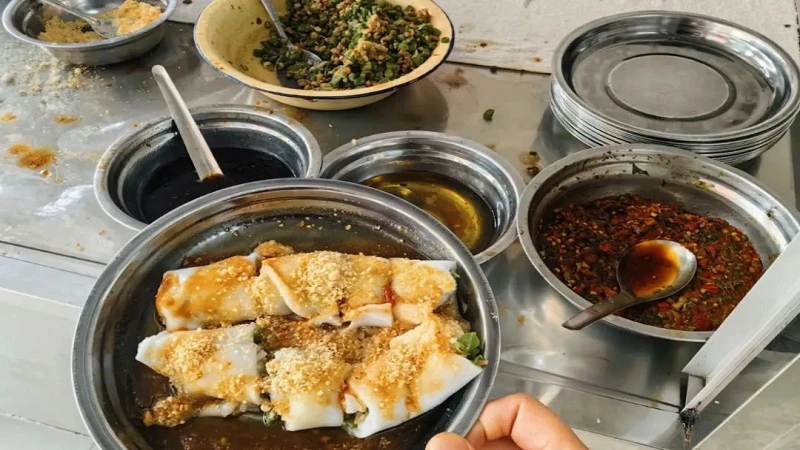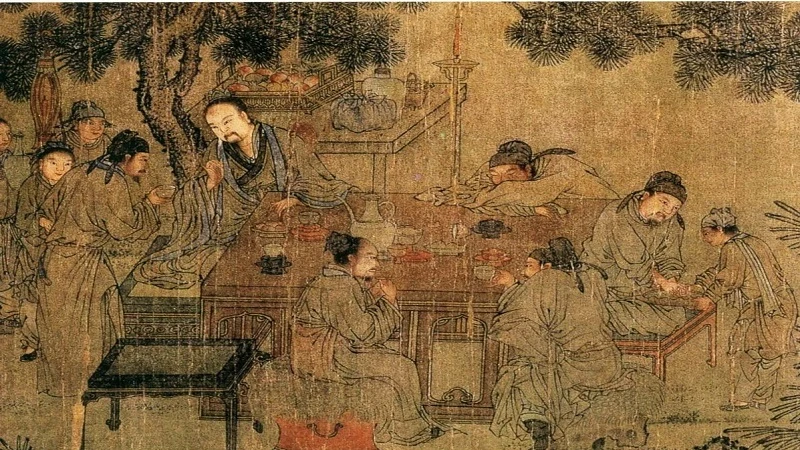-
2025 Beijing Boosts Cuisine to Spur Consumption
Summer's heat ignites Beijing's dining scene, but this year, traditional discounts take a backseat to cultural immersion. Restaurants report a 5% surge in both customers and revenue compared to last summer, driven by innovative blends of heritage, storytelling, and local flavors. From noodle workshops in bustling hutongs to panda-themed feasts and lakeside craft markets, eateries are transforming meals into multidimensional journeys. This shift responds to travelers craving authentic connections beyond taste, proving that Beijing’s culinary identity thrives when chefs become culture keepers. Noodle Literacy Takes Root At Fangzhuang 69 Noodle House, queues stretch longer as tourists master the art of eating Zhajiangmian (炸酱面). Servers demonstrate the "three-step ritual": coating noodles with oil, ladling rich soybean paste, and artfully arranging 12 vibrant seasonal toppings like shredded cucumber, radish, and young garlic. Patrons aren’t just eating; they’re decoding centuries of northern Chinese culinary tradition. Demand for cultural context is palpable. Over 40% of visitors now ask about noodle history and vegetable symbolism, prompting staff training in storytelling techniques. Waiters explain fermentation secrets of the savory brown sauce and the significance of seasonal toppings, even offering key phrases in multiple languages. This cultural appetite has tangible impacts. Monthly garlic consumption alone exceeds 15…- 0
- 0
- 6
-
Luckin Coffee Launches in New York, USA
New York City, a global epicenter of coffee culture dominated by familiar green aprons, has a bold new contender. On June 30th, 2025, Luckin Coffee, China’s coffee giant, quietly opened its first two U.S. stores in Manhattan. Nestled near NYU’s Washington Square and in bustling Midtown, these sleek "PICK UP" shops immediately drew curious crowds. Forget simple translations; Luckin’s arrival marks a deliberate plunge into America's deep coffee waters, promising high quality, digital convenience, and famously competitive prices. But the real test lies not in strategy documents, but in the hands – and taste buds – of New Yorkers grabbing their first cups. First Sips: Surprise & Sweetness Initial reactions from American customers reveal intrigue and pleasant surprises, though not always the expected coffee punch. Alice Tecotzky, reporting for Business Insider, ventured in expecting coffee. Her Pineapple Cold Brew, however, tasted distinctly "like pineapple juice with pulp," a flavor she found pleasant but unexpected. Shaking it didn't fundamentally alter the profile. Her "Sunny Breeze" drink, blending blood orange and grapefruit, earned higher marks for its refreshing, tangy sweetness – though deemed more suitable for an afternoon pick-me-up than a morning caffeine fix. Others embraced the novelty. Bruce Leon, 53, appreciated…- 0
- 0
- 9
-
Cultural Gifts: Ideas for Global Friends
Building genuine connections across cultures enriches our lives. When birthdays or holidays arrive, choosing the right gift for foreign friends becomes more than a gesture—it’s an opportunity to share your heritage while honoring theirs. Thoughtful presents spark joy, foster mutual understanding, and create lasting memories. This guide explores unique, culturally resonant gifts that transcend borders. Handcrafted Cultural Treasures Traditional crafts tell stories of heritage and artistry. Chinese embroidery, like Suzhou or Sichuan styles, showcases intricate techniques passed down for generations. Pieces featuring nature themes—birds, flowers, or pandas—capture attention with vivid detail. These works transform into elegant wall hangings or table displays, offering daily inspiration. One diplomat displayed Suzhou embroidery in her office, prompting colleagues to ask about its symbolism, turning the gift into a conversation starter. Yixing clay teapots represent another timeless choice. Crafted from porous purple clay, these teapots enhance tea flavors over time. Classic designs like the "Shi Piao" (stone dipper) balance form and function. For tea enthusiasts, gifting a small Yixing pot with premium oolong creates an interactive experience. A London-based chef uses his daily, noting how the ritual centers him—proof that utility and tradition coexist beautifully. Culinary Delights from the Region Regional flavors offer edible adventures.…- 0
- 0
- 11
-
Huangshui National Resort Invites You to 21℃ Summer
Nestled high in Chongqing's mist-shrouded peaks, Huangshui National Tourist Resort emerges as an antidote to scorching summers. At 1500 meters above sea level, this alpine refuge maintains a perpetual 70°F (21°C) embrace, earning its "Natural Air-Conditioned City" moniker. Beyond temperature relief, it unfolds a tapestry of crystalline lakes, primeval forests, and vibrant Tujia traditions, transforming escape into profound discovery within its UNESCO-designated latitude. Nature's Masterpieces Moon Lake mirrors the heavens like liquid jade, its 57-acre surface reflecting dense pine forests. Morning transforms the reservoir into an ethereal landscape where kayakers glide through mist veils. As dusk paints the water gold, photographers capture shimmering light patterns unique to these highlands. Each paddle stroke reveals new perspectives on this human-made marvel. Sun Lake's vast 667 acres claim the title of Southwest China's highest freshwater body. Its transparent waters meet stringent Class I quality standards, revealing submerged rock formations. Visitors skim across the surface on motorboats or pedal water cycles along reed-fringed shores. The surrounding trails invite cyclists to explore microclimates where mountain breezes carry wildflower scents. The Emerald Forest (Bizika Green Palace) envelops travelers in 2,165 acres of old-growth woodland. Giant firs form natural cathedrals where sunlight filters through canopy layers. This…- 0
- 0
- 13
-
Seasonal New Products Are Popular for Consumption
China's fashion landscape is no longer just about imported luxury labels or mass-produced apparel. A dynamic transformation is unfolding, driven by a potent fusion of deep-rooted cultural heritage and cutting-edge technological innovation. This synergy is redefining consumer experiences, revitalizing ancient crafts, and reshaping production from the design studio to the factory floor. From the seasonal rhythms celebrated in Beijing's bakeries to the intricate patterns of Shu brocade revived in Chengdu workshops, and the algorithms generating tomorrow's silhouettes in Zhejiang factories, a distinctly Chinese, globally resonant fashion identity is emerging. This movement transcends mere aesthetics; it represents a profound shift where tradition acts as a springboard for futuristic creativity, powered equally by artisan hands and artificial intelligence, fundamentally altering how fashion is conceived, made, and consumed. The Rhythmic Renaissance The humble pastry becomes a canvas for cultural storytelling. In Beijing, establishments like Daoxiangcun have tapped into the nation's growing appetite for experiences infused with tradition. Their "24 Solar Terms" themed stores have become destinations, launching limited-edition pastries aligned with each seasonal marker. The recent "Xiaoshu Cake" (Minor Heat Cake), featuring lotus root and cranberries, exemplifies this trend. Consumers like Ms. Yang seek more than sustenance; they desire products embodying wellness principles…- 0
- 0
- 15
-
Classic Two-day Tour Route of Quanzhou Ancient City
Stepping into Quanzhou is like entering a living theater where history and modernity dance in harmony. As a former hub of the world's maritime trade and the eastern starting point of the Maritime Silk Road, this ancient port city in China's Fujian province offers a captivating blend of cultural heritage, vibrant street life, and culinary delights. With its UNESCO World Heritage status, featuring 22 sites that narrate tales from the Song and Yuan dynasties, Quanzhou invites travelers on an immersive two-day adventure. Wander through centuries-old temples, bustling markets, and serene alleys, all while riding the iconic "little white" electric carts that whisk you between landmarks. Whether you're a history buff, a foodie, or a seeker of tranquility, this compact yet rich itinerary promises unforgettable moments—from dawn prayers at Taoist shrines to twilight feasts under lantern-lit skies. Embrace the city's rhythm, where every corner reveals stories of emperors, traders, and artisans, making it a perfect escape for a short getaway that feels timeless and transformative. Historic Landmarks Explored Begin your journey by arriving at Quanzhou Jinjiang International Airport or the high-speed rail station, easily accessible by public buses that drop you in the heart of the ancient city. Check into one…- 0
- 0
- 9
-
The Ancient Wisdom of Food as Medicine
"Come over next Saturday night," Chef Yang Boying said. "I'll make an old school dish—cordyceps duck. You won't find it in restaurants these days." I arrived right on time. Yang lifted the lid off a steaming pot, releasing the scent of something rich and ancient. Inside was a rustic farm duck, slow-steamed for four hours in a dark, nourishing broth. Sprouting from the skin were black threads that looked like rat tails—twenty pieces of cordyceps, carefully skewered into the flesh. The sight was strange, even a little eerie, but the aroma was unforgettable. Medicine and Food Share the Same Root Cordyceps duck (虫草鸭子), a medicinal classic from 19th-century Sichuan, embodies the Chinese belief that food and medicine share the same root. Once served at Chengdu's Tong Ren Tang—a pharmacy that also sold nourishing dishes—it was never just a meal. Cordyceps, a rare fungus that grows from caterpillars, is prized in traditional Chinese medicine for enhancing energy and immunity. The method used to cook this duck—piercing it and inserting the fungus by hand—was both precise and poetic. Today, few make it this way. The cordyceps are usually tossed into the pot with the duck, no fancy presentation. But Yang prefers the…- 1
- 0
- 26
-
Food Divination: A Gentle Negotiation Between Humans and Fate
Every year, during the Dragon Boat Festival (端午节), you'll see families across China hanging bundles of mugwort (艾草) on their doors, wearing fragrant sachets close to their bodies, and tying colorful threads on children's wrists. In places like Henan and Zhejiang, pots are filled with garlic and eggs. These time-honored traditions, passed down for thousands of years, form a complete "protective system" against evil spirits. But the Dragon Boat Festival isn't just a day to remember the poet Qu Yuan. Its long-standing folk practices signify a celebration of life, a prayer for the living, and a struggle against the uncertainty of life. Traditional Food Rituals as Protection During Festivals A saying goes, "If you don't wear mugwort on Dragon Boat Festival, you'll turn into a ghost after death." Mugwort and calamus, often placed at the thresholds of homes, act like plant-based charms, creating a symbolic barrier to safeguard both family and body. Food, which enters the body directly, forms an even closer connection with people and is given the special power to ward off evil spirits. For example, the red beans, salted egg yolks, and salted meats wrapped inside zongzi (粽子, traditional sticky rice dumplings) are considered "yang objects" (阳物),… -
Top 10 Famous Dishes in Tianjin
Tianjin, a vibrant city in northern China, boasts a rich culinary heritage with unique flavors and cooking techniques. Here's a curated list of the top 10 must-try dishes that define Tianjin's gastronomy, voted by locals and food enthusiasts alike. 1. **Bazhen Doufu (Eight-Treasure Tofu)** A signature Tianjin dish, Bazhen Doufu features crispy fried tofu cubes simmered with eight luxurious ingredients like abalone, sea cucumber, and scallops. The tofu's golden crust contrasts beautifully with its tender interior, absorbing the rich flavors of the seafood medley. Variations exist based on seasonal availability, making each version a delightful surprise. 2. **Chao Qing Xiaren (Stir-Fried River Shrimp)** This award-winning dish showcases Tianjin's freshwater shrimp at their peak in autumn. Uniformly sized shrimp are wok-tossed with crisp cucumber slices, achieving a natural golden hue. The result? A delicate balance of textures—slightly crunchy outside, succulent inside—with a subtle sweetness that highlights the shrimp's freshness. 3. **Jian Peng Daxia (Pan-Seared Prawns)** Tianjin's coastal influence shines in this ruby-red delicacy. Jumbo prawns are pan-seared to perfection, locking in oceanic flavors while developing a caramelized crust. The magic lies in the aromatic base of ginger, garlic, and scallions—a hallmark of Tianjin's expertise with seafood. 4. **Pa Quansu (Braised Assorted…- 0
- 0
- 50
-
Top 10 Famous Dishes in Heilongjiang, Haerbin
Heilongjiang, a province in Northeast China, boasts a rich culinary heritage with unique flavors and cooking techniques. Here are the top 10 famous dishes that represent the essence of Heilongjiang cuisine, as voted by users. 1. **Demoli Stewed Live Fish (东北美食)** **Category**: Northeast Cuisine **Origin**: Demoli Village **Description**: Originating from a small village near Harbin, this dish features fresh carp (or catfish) stewed with tofu and wide noodles. It is known for its rich flavor and nutritional benefits, including promoting digestion and preventing osteoporosis. 2. **Flying Dragon Soup (东北菜)** **Category**: Northeast Cuisine **Origin**: Xing'an Mountains **Description**: Made with hazel grouse, this clear soup is a delicacy in Heilongjiang. It is prepared with minimal seasoning to preserve its natural umami taste and is prized for its 滋补 (tonic) properties. 3. **Steamed Pork with Hazel Mushrooms (东北菜)** **Category**: Northeast Cuisine **Description**: A hearty dish combining pork belly and hazel mushrooms, steamed to perfection. The mushrooms add a distinct earthy flavor and are rich in protein and essential amino acids. 4. **Guobaorou (锅包肉, 家常菜)** **Category**: Home - style Dish **Origin**: Northeast China **Description**: Crispy fried pork slices coated in a sweet and sour sauce, this dish is a staple in Heilongjiang households. It…- 0
- 0
- 70
-
Top 10 Famous Dishes in Chongqing
Chongqing, a city renowned for its bold and spicy flavors, boasts a rich culinary heritage. Here's a curated list of the top 10 must-try dishes that define the essence of Chongqing cuisine, based on popular votes and expert recommendations. 1. **Shuizhuyu (水煮鱼) - Boiled Fish in Chili Oil** A quintessential Sichuan dish, Shuizhuyu features tender fish slices simmered in a fiery broth of chili oil and Sichuan peppercorns. The dish is known for its numbing spiciness and aromatic flavors, making it a favorite among spice lovers. 2. **Pijiuya (啤酒鸭) - Beer Duck** This dish combines succulent duck meat with the rich flavors of beer, creating a hearty and aromatic stew. The duck is braised until tender, absorbing the malty sweetness of the beer, resulting in a dish that is both flavorful and comforting. 3. **Qianjiangjiza (黔江鸡杂) - Qianjiang Chicken Giblets** A spicy stir-fry of chicken giblets (heart, liver, gizzard, and intestines) with pickled peppers and vegetables. The dish is celebrated for its bold flavors and crunchy texture, offering a unique taste of Chongqing's rustic cuisine. 4. **Chongqing Kaoyu (重庆烤鱼) - Chongqing Grilled Fish** A fusion of grilling and braising, this dish features fish grilled to perfection and then simmered in…- 0
- 0
- 51
-
Top 10 Famous Dishes in Jilin
Jilin Province, located in northeastern China, boasts a rich culinary heritage with a variety of unique and flavorful dishes. Here is a list of the top 10 famous dishes in Jilin, each with its own distinct taste and cultural significance. 1. Xueyi Dousha (Snowy Red Bean Paste) Category: Jilin Cuisine Xueyi Dousha is a traditional Manchu dessert made primarily from red bean paste and egg whites. The dish is known for its fluffy texture and sweet taste, often dusted with sugar before serving. It is a popular choice among locals and visitors alike. 2. Shaguo Lubao (Deer Treasure Casserole) Category: Gourmet Food This dish features deer tendons, deer tails, and other deer parts, cooked in a casserole with a rich broth. It is a nutritious and flavorful dish, often enjoyed during the colder months. 3. Qingzheng Baiyu (Steamed White Fish) Category: Northeastern Cuisine Originating from the Songhua River, this dish is made with fresh white fish, steamed to perfection with a light broth. It is known for its tender meat and delicate flavor. 4. Renshen Ji (Ginseng Chicken) Category: Gourmet Food A signature dish of Jilin, Renshen Ji combines tender chicken with ginseng, a prized local ingredient. The dish is…- 0
- 0
- 114
-
Top 10 Inner Mongolian Cuisine Delicacies
Inner Mongolia boasts a rich culinary heritage, deeply rooted in its nomadic traditions and unique geographical landscape. Here's a curated list of the top 10 must-try dishes that define the region's gastronomic identity, each offering a distinct taste of Mongolian culture and hospitality. 1. **Qingtang Niuwei (Clear Soup Oxtail)** A traditional homestyle dish, Qingtang Niuwei features tender oxtail simmered in a clear, flavorful broth with radish and bamboo shoots. Legend traces its creation to a master chef during the pre-liberation era. The slow-cooked oxtail becomes exceptionally tender, absorbing the essence of chicken stock, ginger, and scallions, resulting in a nutritious and aromatic soup. 2. **Neimeng Kao Quanyang (Inner Mongolian Roast Whole Lamb)** The crown jewel of Mongolian cuisine, this ceremonial dish symbolizes hospitality. A 40 - jin pasture - fed lamb is marinated with scallions, ginger, and spices before being roasted whole until golden. The crispy skin encases succulent meat, offering a perfect balance of textures – a true feast for royalty and special occasions. 3. **Quan Yang Tang (Whole Lamb Soup)** This hearty soup utilizes nearly every part of the lamb (excluding wool). Thinly sliced organs and meat cook briefly in boiling broth, finished with pepper and cilantro. Served…- 0
- 0
- 96
-
Top 10 Famous Dishes in Hebei
Hebei Province boasts a rich culinary heritage with a variety of iconic dishes. Here is a curated list of the top 10 famous dishes from Hebei, based on popular votes and historical significance. 1. Jingdong Braised Pork Knuckle (京东煨肘子) A signature dish from Tangshan, Hebei, this braised pork knuckle is cooked with a rich broth, red dates, goji berries, and a blend of seasonings. The result is tender, flavorful meat that melts in your mouth. It's known for its health benefits, particularly for bone strength. 2. Cangzhou Lion's Head (沧州狮子头) Named after the "Lion City" of Cangzhou, this dish features large meatballs made with minced pork and lotus root, deep-fried to a crispy exterior while remaining juicy inside. It can be served braised or steamed. 3. Stir-Fried Pork Kidney (溜腰花) A Cantonese-inspired dish popular in Hebei, this stir-fried pork kidney is crispy and aromatic, cooked with bell peppers and a savory sauce. It’s a favorite for its rich flavor and nutritional value. 4. Chicken with Shrimp (鸡里蹦) A historic dish dating back to the Qing Dynasty, this combines tender chicken and fresh shrimp stir-fried with sweet bean sauce. Its unique name comes from the lively movement of shrimp during cooking.…- 0
- 0
- 120
-
Top 10 Famous Shandong Dishes
Shandong cuisine, also known as Lu cuisine, is one of the eight major culinary traditions in China. Renowned for its rich flavors, fresh ingredients, and meticulous preparation, Shandong dishes have gained popularity both domestically and internationally. Below is a curated list of the top 10 most famous Shandong dishes, each with its unique history, preparation methods, and cultural significance. 1. Congshao Haishen (Braised Sea Cucumber with Scallions) Originating from the Jiaodong Peninsula, this dish is a hallmark of Shandong cuisine. The sea cucumber, often sourced from high-quality varieties like Liao Shen or Heiyu Shen, is braised with scallions to neutralize any fishy odors. The result is a harmonious blend of rich flavors and textures, making it a favorite at banquets and family gatherings. 2. Baochao Yaohua (Stir-Fried Pork Kidney) A classic Lu dish, Stir-Fried Pork Kidney is celebrated for its tender texture and robust flavor. The kidneys are sliced thinly and stir-fried with scallions, soy sauce, and a mix of seasonings. The dish is known for its balance of sweetness, sourness, and spiciness, appealing to a wide range of palates. 3. Tangcu Liyu (Sweet and Sour Carp) A staple at celebratory events like weddings, Sweet and Sour Carp is a…- 0
- 0
- 96
-
Top 10 Anhui Cuisine Dishes
Anhui cuisine, also known as Hui cuisine, is one of the eight major culinary traditions in China. Known for its use of wild herbs and simple cooking methods, it offers a unique blend of flavors. Below is a list of the top 10 Anhui dishes that have gained popularity among food enthusiasts. 1. Fuliji Roast Chicken (Hui Cuisine) Fuliji Roast Chicken is a traditional dish from Suzhou, Anhui. Originating in the early 20th century, it was officially named in 1951 and later recognized as a national delicacy. The dish is famous for its tender meat, rich aroma, and balanced flavors. 2. Huizhou One - Pot (Hui Cuisine) This winter specialty from Huizhou is a type of hot pot that combines various premium ingredients. Created during the Ming Dynasty, it is often compared to Fujian's Buddha Jumps Over the Wall for its exquisite taste. 3. Honey - Glazed Sweet Potato (Yanhuai Cuisine) A traditional sweet dish from Huaibei, Anhui, this dish features caramelized sweet potatoes with a glossy, translucent appearance. It is a popular choice for banquets due to its delightful taste and simple preparation. 4. Bagongshan Tofu (Hui Cuisine) Originating from Huainan, this tofu is known for its smooth texture…- 0
- 0
- 151
-
Top 10 Famous Dishes in Yunnan
Yunnan, a province in southwestern China, is renowned for its diverse and flavorful cuisine. Here is a list of the top 10 famous dishes in Yunnan, each with its unique taste and cultural significance. 1. Dali Clay Pot Fish (Dali Shaguo Yu) Category: Yunnan - Guizhou Cuisine Origin: Dali Description: Dali Clay Pot Fish is a local delicacy made with fresh fish from Erhai Lake, cooked in a clay pot from Xiangyun. The dish is rich in flavor, with tender fish meat and a fragrant broth. It is often served on a large plate with leafy greens, creating a colorful and aromatic presentation. 2. Old Kunming Lamb Hotpot (Lao Kunming Yangtang Guo) Category: Yunnan Cuisine Description: This classic Yunnan dish features lamb meat and offal, slow - cooked to perfection. The broth is rich and flavorful, with a spicy and aromatic dipping sauce. The dish is a favorite among locals for its hearty and comforting taste. 3. Dali Raw Pork (Dali Shengpi) Category: Meat Dish Origin: Yunnan Description: Dali Raw Pork is a traditional Bai ethnic dish, made with thinly sliced pork and a variety of dipping sauces. The pork is fresh and tender, with no special smell, and is…- 0
- 0
- 59
-
Top 10 Tibetan Cuisine Delicacies
Tibetan cuisine is renowned for its unique flavors and rich cultural heritage. Here’s a curated list of the top 10 must-try dishes from Tibet, each offering a glimpse into the region’s culinary traditions. 1. **Tun Guanchang (Boiled Sausage)** A staple in Tibetan households, this dish features sheep intestines stuffed with a mix of blood, meat, and barley or bean flour. It’s traditionally prepared during festivals and loved for its distinctive texture and flavor. 2. **Zheng Niushe (Steamed Beef Tongue)** A tender and aromatic delicacy, steamed beef tongue is lightly seasoned to highlight its natural taste. Often served cold or hot, it’s a favorite for its simplicity and rich flavor. 3. **Zha Guanfei (Fried Lung Sausage)** A crispy and savory snack made from sheep lungs, butter, and flour. Its origins trace back centuries, and it remains a popular street food in Lhasa. 4. **Suancai Miankuai (Sour Vegetable Noodles)** A comforting dinner dish combining homemade sour vegetables, hand-pulled noodles, and local dried meat or yak beef. The tangy, spicy broth is both hearty and refreshing. 5. **Gangba Kao Quanyang (Gangba Roast Whole Lamb)** A celebratory dish, this roast lamb is marinated with local spices and slow-cooked to perfection. The meat is juicy…- 0
- 0
- 78
-
Top 10 Shanghai Dishes You Must Try
Shanghai, a bustling metropolis in China, is not only famous for its skyline but also for its rich culinary heritage. Here's a curated list of the top 10 must - try dishes that represent the essence of Shanghai cuisine, loved by locals and visitors alike. 1. Braised Pork Knuckle (Hongshao Tizhang) A specialty from Kunshan, this dish features tender pork knuckle slow - cooked with a blend of spices. It's known for its rich flavor and nutritional benefits, including high protein content. Perfect for those seeking a hearty meal, though moderation is advised for those with dietary restrictions. 2. Crystal Shrimp (Shuijing Xiaren) A classic Shanghai dish, Crystal Shrimp is celebrated for its translucent appearance and delicate taste. Originating from a blend of Cantonese and Fujian culinary techniques, this dish is a testament to Shanghai's innovative spirit in cuisine. 3. Vegetarian Crab Meat (Su Xiefen) A creative vegetarian alternative, this dish uses potatoes and carrots to mimic the texture and flavor of crab meat. It's a colorful, nutritious option that showcases the ingenuity of Shanghai's vegetarian cuisine. 4. Shanghai Braised Pork (Hongshao Rou) This iconic dish is a staple in Shanghai households. Made with pork belly, soy sauce, and sugar,…- 0
- 0
- 47
-
The 8 Great Chinese Cuisines and Iconic Dishes
Unlike Western culinary classifications by courses or ingredients, Chinese cuisine categorizes itself through philosophical flavor balance and geographical personality. The eight recognized styles - Shandong (鲁菜), Sichuan (川菜), Cantonese (粤菜), Jiangsu (苏菜), Zhejiang (浙菜), Fujian (闽菜), Hunan (湘菜), and Anhui (徽菜) - each developed unique characteristics shaped by local topography, historical trade routes, and imperial influences. The eight cuisines follow different culinary principles - Cantonese chefs prioritize Wok Hei (breath of the wok 锅气) through quick frying, while Anhui cuisine employs slower braising methods to extract depth from mountain herbs and preserved goods. Understanding the "Eight Great Cuisines" (八大菜系) provides the key to appreciating Chinese complex edible culture. As we examine each cuisine's signature techniques, historical influences, and philosophical underpinnings, prepare to discover how imperial edicts shaped flavor preferences and how climate dictated regional preservation methods that became beloved flavors. Shandong Cuisine Rooted in the fertile plains and rugged coastlines of eastern China, Shandong Cuisine stands as the grand progenitor of China's culinary traditions, its influence radiating through royal kitchens and humble hearths for over 2,500 years. Born in the homeland of Confucius, this cuisine marries the pragmatism of northern Chinese life with the poetic discipline of ancient rituals, creating…- 0
- 0
- 130
-
The Ultimate Chengdu Travel Guide - International Travelers
Chengdu, China's "Land of Abundance," is more than just the hometown of giant pandas. This 2,300-year-old city in Sichuan Province is a living museum of Han Dynasty relics, UNESCO-listed cuisine, and a gateway to Tibet's eastern foothills. For International Travelers fascinated by China's history, spirituality, and culinary arts, Chengdu offers an immersive blend of ancient traditions and cosmopolitan energy. Let's unlock your perfect trip! Visa & Entry: Stress-Free Arrival 144-Hour Visa-Free Transit Citizens from 53 countries (including the US, UK, Canada, and EU nations) can enjoy Chengdu's 144-hour visa-free policy when transiting through Chengdu Shuangliu International Airport. Requirements: Valid passport (6+ months). Onward flight ticket to a third country/region within 144 hours. Restricted travel area: Chengdu, Leshan (Giant Buddha), Ya'an (panda base), and select cities. Pro Tip: Avoid Jiuzhaigou Valley—it's outside the visa-free zone. Regular Tourist Visa (L Visa) For longer stays or broader travel plans, apply for a China Tourist Visa at your local embassy. Processing takes 4–7 days. You can apply for this at your nearest Chinese embassy or consulate. The process typically requires your passport, a completed application form, a recent photo, and proof of your travel itinerary and accommodation bookings. Some nationalities may also need to…- 0
- 0
- 81
-
Forged in Flames: The Artistry of Quanjude's Peking Duck
In the heart of Beijing, where ancient Hutongs whisper tales of dynasties past, a culinary masterpiece has been perfected over 160 years—not in the quietude of a scholar's study, but in the roaring flames of a hanging oven. Quanjude (全聚德) Peking Duck, a dish synonymous with imperial grandeur and modern ingenuity. Since its founding in 1864 by Yang Quanren, a visionary duck vendor from Hebei, Quanjude has transformed the humble duck into a cultural icon, its roasting technique enshrined in 2008 as a National Intangible Cultural Heritage. Yang's genius lay not merely in recipe, but in ritual. Passing through seven generations of masters—each apprenticed in the sacred fires of the oven—the art of Quanjude's hanging-oven roasting (挂炉烤鸭技艺) has endured wars, revolutions, and the frenetic pulse of globalization. Today, as the aroma of applewood-smoked duck wafts through its doors, Quanjude stands as both guardian and innovator: a ¥1 billion-a-year empire straddling tradition and modernity. How to Handle Crisp and Tenderness To witness a Quanjude chef at work is to observe a choreography as precise as calligraphy. The creation of a perfect Peking duck unfolds in two acts: zhì bēi (制坯, crafting the blank canvas) and kǎo zhì (烤炙, the baptism by…- 0
- 0
- 131
-
The Most Underrated Tourist City Located on Chinese Southern Border
Tucked along China's southern border with Vietnam, Chongzuo is Guangxi's best-kept secret—a city where misty karst peaks, sugarcane fields stretching to the horizon, and a fusion of Zhuang and Vietnamese cuisines create a sensory feast. Let's dive into why Chongzuo deserves a spot on your China travel radar. While Guangxi's Guilin and Liuzhou hog the spotlight, Chongzuo offers an authentic, crowd-free taste of China's southern frontier. Here, every meal is a cross-cultural journey, and every landscape feels plucked from a poet's dream. As one local chef told me: "We don't just cook food—we stir-fry mountains and steam rivers." Nature's Masterpieces Start with the Detian Waterfall, Asia's largest transnational waterfall straddling the China-Vietnam border. Imagine turquoise cascades thundering through emerald forests—it's like stepping into a fantasy film. Detian Waterfall is a thunderous spectacle where turquoise waters plunge 70 meters into a misty basin. Take a bamboo raft ride to feel the spray on your face—and snap a photo with Vietnam's side of the falls in the background. For history lovers, the Zuojiang Huashan Rock Art, a UNESCO World Heritage Site, features 2,000-year-old cliff paintings that whisper tales of ancient rituals. Detian Transnational Waterfall: Asia's Most Dramatic Cascade And don't miss Mingshi…- 0
- 0
- 93
-
The Aesthetic of Symbolic Food in the Song Dynasty
If one could time-travel back to the bustling streets of the Song Dynasty, the most astonishing sight might not be the vibrant marketplaces or the lively entertainment districts, but rather the mesmerizing artistry found in everyday food. Vendors pushed wooden carts filled with lifelike fruit confections), crafting stunning edible illusions. Among these, the smiling face snacks stood out—honey-glazed plum slices carved into smiling female faces, with dried peaches as blushing cheeks and almonds as delicate teeth. These delicate creations often prompted literati to pause and compose verses, likening the treats to well-crafted smiles. At the grand feasts of the capital's famed establishments, culinary creativity reached new heights. The spectacle of pavilion desserts amazed onlookers: dough tinted with locust flower juice formed gray-tiled roofs, malt sugar spun into intricate railings, and date paste molded into miniature rock formations. Green bean jelly shimmered like a pond's surface, while delicate layers of green bean powder mimicked mossy textures. These microcosmic landscapes were not only admired but also eaten with ceremony—at one banquet, guests were instructed to first drink three cups of wine before disassembling the meandering stream pavilion by consuming its sugar pillars. Poetic Bites: Where Literature Meets Cuisine The rise of symbolic…- 0
- 0
- 102






















